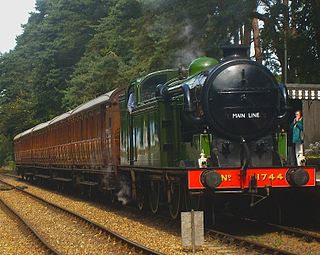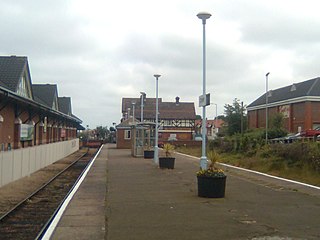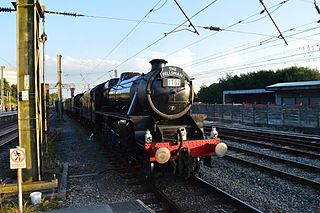
The North Norfolk Railway (NNR) – also known as the "Poppy Line" – is a 5+1⁄4-mile (8.4 km) heritage steam railway in Norfolk, England, running between the towns of Sheringham and Holt. The North Norfolk Railway is owned and operated as a public limited company, originally called Central Norfolk Enterprises Limited. The railway is listed as exempt from the UK Railways (Interoperability) Regulations 2000.

Sheringham is a seaside town and civil parish in the county of Norfolk, England. The motto of the town, granted in 1953 to the Sheringham Urban District Council, is Mare Ditat Pinusque Decorat, Latin for "The sea enriches and the pine adorns".

The Great Central Railway (GCR) is a heritage railway in Leicestershire, England, named after the company that originally built this stretch of railway. It runs for 8.25 miles (13.28 km) between the town of Loughborough and a new terminus in the north of Leicester. It has period signalling, locomotives and rolling stock.

70013 Oliver Cromwell is a British Railways Standard Class 7 preserved steam locomotive. The locomotive is notable as one of the four steam locomotives which worked the last steam railtour on British Railways (BR) in 1968.

The BR Standard Class 7, otherwise known as the Britannia Class, is a class of 4-6-2 Pacific steam locomotive designed under Robert Riddles for use by British Railways for mixed-traffic duties. 55 were constructed between 1951 and 1954. The design employed results from the 1948 locomotive exchanges undertaken in advance of further locomotive classes being constructed. Three batches were constructed at Crewe Works, before the publication of the 1955 Modernisation Plan.

The Bittern Line is a railway branch line in Norfolk, England, that links Norwich to Sheringham. It passes through the Broads on its route to an Area of Outstanding Natural Beauty on the north Norfolk coast. It is named after the bittern, a rare bird found in the reedy wetlands of Norfolk.

Norwich railway station is the northern terminus of the Great Eastern Main Line in the East of England, serving the cathedral city of Norwich, Norfolk. It is 114 miles 77 chains (185.0 km) down the main line from London Liverpool Street, the western terminus.

British Railways Standard Class 7 'Britannia Class' No. 70000 Britannia is a preserved steam locomotive, owned by the Royal Scot Locomotive and General Trust.

The Great Eastern Railway (GER) Class Y14 is a class of 0-6-0 steam locomotive. The LNER classified them J15.

Great Western Railway (GWR) 6000 Class 6023 King Edward II is a preserved steam locomotive.

Stanier Class 5 4-6-0 5231 is a preserved British steam locomotive. In preservation, it has carried the names 3rd (Volunteer) Battalion The Worcestershire and Sherwood Foresters Regiment and The Sherwood Forester, though it never carried either of these in service.

Hoveton & Wroxham railway station is on the Bittern Line in Norfolk, England, serving the village of Hoveton and the adjacent village of Wroxham. It is 8 miles 61 chains (14.1 km) down the line from Norwich and is situated between Salhouse and Worstead.

Roughton Road railway station is on the Bittern Line in Norfolk, England, on the outskirts of the town of Cromer. It takes its name from the street on which it is located, and is several miles north of the village of Roughton. It is 24 miles 1 chain (38.6 km) down the line from Norwich and is situated between Gunton and Cromer stations.

West Runton railway station is on the Bittern Line in Norfolk, England, serving the village of West Runton. It is 28 miles 55 chains (46.2 km) down the line from Norwich and is situated between Cromer and Sheringham, the northern terminus. Train services are operated by Greater Anglia.

Sheringham railway station is the northern terminus of the Bittern Line in Norfolk, England, serving the town of Sheringham. It is 30 miles 22 chains down the line from Norwich. Its three-letter station code is SHM.

Cromer is a railway station in the English county of Norfolk. Because the Midland and Great Northern Joint Railway (M&GNJR) line approached Cromer from the west, following the coastal clifftops, it avoided the steep escarpment which had prevented the earlier line from Norwich running all the way into the town. Consequently, it became possible to build a far more conveniently located station, near to the town centre and the beach. The station opened as Cromer Beach on 16 June 1887 and was renamed Cromer on 20 October 1969, following the closure of Cromer High station in 1954. It is 26 miles 52 chains (42.9 km) down the line from Norwich. Cromer is one of only two former Midland and Great Northern Joint Railway stations to remain operational on the National Rail network; the other being the neighbouring West Runton. Sheringham and Weybourne are the other two surviving M&GNJR stations; both are still served today on the heritage North Norfolk Railway.

Sheringham is the name of a preserved railway station in Sheringham, Norfolk. It was once part of the Midland and Great Northern Joint Railway network and closed in 1967 when a new station was opened by British Rail approx. 200m eastwards. Since 1975 it has served as the eastern terminus of the North Norfolk Railway. In March 2010, the link to Network Rail was reinstated.

The Fifteen Guinea Special was the last main-line passenger train to be hauled by steam locomotive power on British Rail on 11 August 1968 before the introduction of a steam ban that started the following day, the extra day added to allow for the movement of locomotive BR Standard Class 7 70013 Oliver Cromwell to Bressingham Steam Museum. It was a special rail tour excursion train organised for the occasion from Liverpool Lime Street via Manchester Victoria to Carlisle and back, and was pulled in turn by four steam locomotives during the four legs of the journey. The last scheduled standard gauge steam-hauled passenger services had run on 3 August 1968 from Preston. Steam continued to be used on the narrow gauge Vale of Rheidol Railway under British Rail, which was subsequently privatised in 1989.
The Wymondham to Wells Branch was a railway built in stages by the Norfolk Railway, Eastern Counties Railway and Wells and Fakenham Company between 1847 and 1857. The railway ran from Wymondham in the south, through Dereham and Fakenham to the coastal town of Wells-next-the-Sea; more specifically, the line ran from Wymondham South Junction, where it met the present-day Breckland Line. Passenger services along the line lasted until 1969; the railway continued to be used for freight until 1989. The southern section of the railway now forms the Mid-Norfolk Railway, with part of the northern section serving as the narrow gauge Wells and Walsingham Light Railway.

LMS Stanier Class 5MT 4932, is a preserved British steam locomotive. It is one of 18 surviving members of the Black 5 class which had 842 members constructed by five manufacturers. 44932 is the sole remaining member of the class which was built at the LMS's Horwich Works.




















